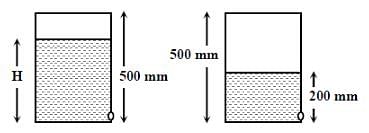Test: Mechanical Properties of Fluids (October 9) - NEET MCQ
10 Questions MCQ Test Daily Test for NEET Preparation - Test: Mechanical Properties of Fluids (October 9)
In rising from the bottom of a lake, to the top, the temperature of an air bubble remains unchanged, but its diameter gets doubled. If h is the barometric height (expressed in m of mercury of relative densityρ) at the surface of the lake, the depth of the lake is [1994]
The wetability of a surface by a liquid depends primarily on [NEET 2013]
| 1 Crore+ students have signed up on EduRev. Have you? Download the App |
A wooden block, with a coin placed on its top, floats in water as shown in figure. The distances l and h are shown there. After some time the coin falls into the water. Then


A wooden cylinder of diameter 4r, height h and density r/3 is kept on a hole of diameter 2r of a tank, filled with water of density r as shown in the figure. The height of the base of cylinder from the base of tank is H.
Let the cylinder is prevented from moving up, by applying a force and water level is further decreased. Then, height of water level (h2 in figure) for which the cylinder remains in original position without application of force is
[JEE 2006]
A glass tube of uniform internal radius (r) has a valve separating the two identical ends. Initially, the valve is in a tightly closed position. End I has a hemispherical soap bubble of radius r. End 2 has sub-hemispherical soap bubble as shown in figure. Just after opening the valve.
[JEE 2008]
A small spherical monoatomic ideal gas double is trapped inside a liquid of density r, (see figure). Assume that the bubble does not exchange any heat with the liquid. The bubble contains n moles of gas. The temperature of the gas when the bubble is at the bottom is T0, the height of the liquid is H and the atmospheric pressure is P0 (Neglect surface tension).
[JEE 2008]
Figure :
The buoyancy force acting on the gas bubble is (Assume R is the universal gas constant)
A cylindrical vessel of height 500 mm has an orifice (small hole) at its bottom. The orifice is initially closed and water is filled in it up to height H. Now the top is completely sealed with a cap and the orifice at the bottom is opened. Some water comes out from the orifice and the water level in the vessel becomes steady with height of water column being 200 mm. Find the fall in height (in mm) of water level due to opening of the orifice. [Take atmospheric pressure = 1.0 × 10 5 Nm-2 , density of water = 1000 kg m-3and g = 10 ms-2 . Neglect any effect of surface tension.] (Take temperature to be constant)
[JEE 2009]
Two solid spheres A and B of equal volumes but of different densities dA and dB are connected by a string. They are fully immersed in a fluid of density dF. They get arranged into an equilibrium state as shown in the figure with a tension in the string. The arrangement is possible only if
[JEE 2011]
A rectangular block of mass m and area of crosssection A floats in a liquid of density ρ. If it is given a small vertical displacement from equilibrium it undergoes oscillation with a time period T. Then [2006]
The angle of contact between pure water and pure glass, is [1996]
|
12 docs|366 tests
|























